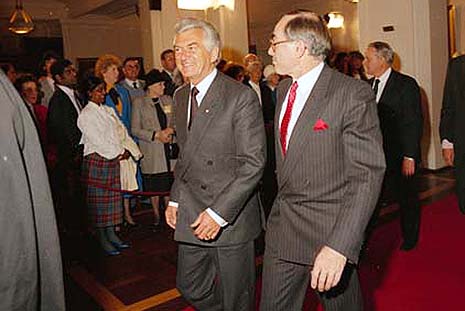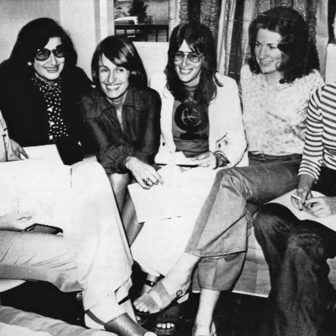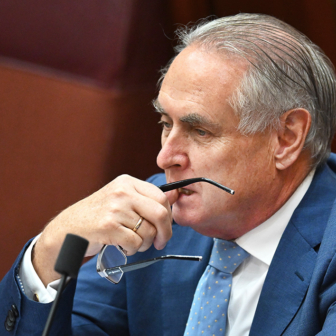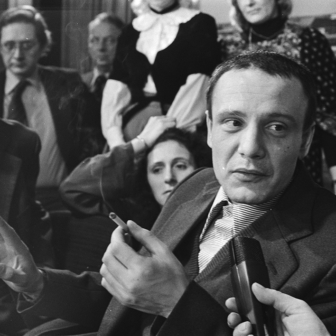WHEN Kevin Rudd called the 7 September election while Labor was still trailing in the polls, campaign historians might have assumed he was trying to do a “Hawke 1987” – build on his pre-campaign momentum, make every week a winner, and ride home over the top of a flagging opposition.
But if recent press reports of tensions and divisions within the Labor campaign are to be believed, Rudd might be heading for a “Keating 1996” – a tired government with a disorganised campaign rolled by a relentless, disciplined and elusive opposition. Of course, if Tony Abbott were to lose the unlosable election next month, he would make “Hewson 1993” look like a positive triumph.
Historical parallels like these are not only interesting but also instructive. When it comes to understanding contemporary election campaigns, the past is a useful guide – not least because the campaign directors of both parties devise strategies and tactics based on what they know has, and hasn’t, worked before. The party that learns best, and adapts most rapidly, and is most professional, will tend to be best placed to win. The party that forgets what it takes to win – forgets the disciplines of how to run a centralised, well-organised campaign – is asking for trouble.
This is why the reports of bickering and finger-pointing between Kevin Rudd’s advisers and national secretary George Wright and his staff in Labor’s campaign headquarters are not only bad signs in themselves. If true, they indicate that Labor – which pioneered so many aspects of professional election campaigning – appears to have forgotten some key lessons.
Alongside the history, understanding a campaign also requires a sense of what is different this time around. When the history of the 2013 campaign comes to be told, it will be clear that some features are quite distinctive. In fact, from the strategic point of view, it’s already possible to discern three ways in which this campaign differs from any we have seen before.
First is the issue of minority government. No government has faced the people in such a weak position as Labor does now – weak in the polls, but weaker still in terms of parliamentary seats. Under Julia Gillard, Labor was facing the prospect – unprecedented for any major party – of entering a campaign knowing it had absolutely no chance of winning a parliamentary majority in the House of Representatives. Gillard would have campaigned to “save the furniture” (shoring up its safe seats by appealing to the party faithful) and to “go down with guns blazing” (laying down a policy legacy for the future).
Under Rudd, that dire outcome seems to have been avoided. But the electoral arithmetic has not changed. Lacking a majority, the government campaigns without the usual advantages of incumbency in key marginal seats. Moreover, having relied on a growing number of independents, Labor cannot just run a defensive campaign to hold on to its existing seats; to win, it must go on the offensive and somehow take seats from the opposition. Yet the polls suggest that even defending the core – in western Sydney and elsewhere – is no easy task.
Labor’s strategic dilemma works in happy reverse for the Coalition: counting the independent seats, it already has a majority. It can campaign defensively to hold this position while having the option of focusing maximum firepower on picking off selected Labor-held seats.
Second is the issue of leadership instability. Amid all the commentary about the rising tide of leadership instability over the last decade, one important implication has been overlooked: it is almost impossible to plan a campaign when the leader changes at short notice.
Both parties spent most of 2013 planning campaigns around a Gillard–Abbott contest on 14 September. Rudd’s last-minute resurrection has forced major rethinking. This must have posed difficulties for the Liberals, who are facing a tighter contest against a less vulnerable opponent. But as the governing party the bigger strategic challenge is Labor’s. No prime minister has ever won a majority after entering the Lodge so soon before calling the election. (The closest thing to a precedent is Julia Gillard’s 2010 campaign, which produced the hung parliament – hardly a happy example.)
For the most part, prime ministers and – with the exception of Bob Hawke in 1983, who served just a few weeks – opposition leaders have been in place for two or three years. They have become familiar to the public, they have sorted out their policy priorities, and the party organisation has been able to plan an electoral strategy around them. But while Abbott is able to talk about the stability of his team and the consistency of his message, Rudd Labor is still reintroducing itself to the electorate. Most of Rudd’s activity has been about clearing the policy decks for the election; there has been no sign of any sort of agenda for the third term.
How quickly the Labor campaign was able to shift from a Gillard (save the furniture) strategy to a strategy about the new-old Rudd remains to be seen. But campaigns under new leaders tend by necessity to be improvised – recall Latham in 2004 – and this in turn creates tensions between the new leader and the party’s head office. This may be what is happening inside Labor now.
TO EXPLAIN why this is serious requires a short detour into party headquarters. Since the 1970s, Labor’s national secretary and the Liberals’ federal director have invariably been appointed as national campaign directors. The point of having a national campaign director is to get all the state branches, all the volunteers, all the marketing agencies, all the MPs, all the candidates, and the entire parliamentary leadership – including, most importantly, the leader – singing the same song.
The job is partly a logistic one: getting all the party’s resources focused on the goal of victory, and coordinating the ever-growing array of campaign activities from TV advertising and social media to debate negotiations and polling-day bunting. Getting these logistics right requires more than just a good brain for detail. It needs strategic overview, so that all the detailed pieces are assembled into a coherent plan and contribute to the goal of that parliamentary majority.
In the most successful election campaigns, the campaign director has also been the chief strategist. Of course he or she works in a team – with the market researcher, the ad agency, the leader’s office, some of the state secretaries. But for Bob McMullan (Labor’s campaign director of Hawke’s victories in 1983, 1984 and 1987) and for Andrew Robb and Lynton Crosby (the Liberals’ campaign directors of Howard’s victories in 1996, 1998 and 2001), developing and executing the campaign strategy was their responsibility and the most important part of their job.
The iron law of election campaigning is that successful campaign organisations have just one campaign director. There will be many egos, but a consistent campaign message requires the discipline of a centralised campaign organisation.
In 1996, by contrast, prime minister Paul Keating was permitted to indulge the fancy that he knew more about campaign management than the actual campaign manager, party secretary Gary Gray. As Pamela Williams wrote at the time, Keating insisted that his “instincts” were superior to anything the “ad agency or focus group” could throw up, and demanded more negative advertising. Gray refused: he thought it was misdirected and regarded Keating’s unpredictability – his nickname was Captain Wacky – as fatal to his efforts to run a consistent strategy. Keating stuck with his own instincts and went down in flames.
Political leaders like Keating – and perhaps Rudd, given that the polls suggest he is the only thing standing between Labor and annihilation – have a tendency to regard themselves as their own best source of campaign advice. Keating told Gray, “I cannot have a position where my instincts as party leader run for three years but not in the last week of the campaign.” A professional campaign manager would reply: the weeks of the campaign are precisely the time when instincts and intuition and improvisation should give way to dispassionate calculation and focused effort to win over the key voters.
Keating’s preference for instinct was supported and facilitated by his group of personal advisers, led by Don Russell, who had returned from the embassy in Washington to work with Keating. Russell admired the US practice where, as he told Pamela Williams, the president appoints the campaign manager. Australia’s system of having a party official as campaign director was “weird.”
Interestingly, Rudd may have taken this to the next step by appointing a political consultant to his personal office. Veteran campaign consultant Bruce Hawker is a trusted loyalist and experienced campaign manager in his own right. In appointing him, Rudd has created a non-formal, personalised advice structure along the lines of a US presidential campaign. If there are divisions between the campaign director and the leader’s entourage, this innovation would allow the leader to “go it alone” rather than knuckle under the party’s campaign structure.
THE third distinctive strategic factor in 2013 is the long shadow cast by Barack Obama – or more precisely by his campaign team led by David Axelrod. Labor has set about emulating the Obama team’s intensive field organising program. It has imported personnel and talent to build up a structure of volunteers, phone-banks and databases designed to target swinging voters more precisely than has been possible before and to reach them more intensively. It is also designed to raise “high-volume, low-value” donations from party supporters.
Hence, we see George Wright appearing in a video to supporters in the first week of the campaign. This was unusual and innovative in a number of respects. Party officials usually keep a low profile, leaving the politicians to do the public work. They also keep the campaign headquarters out of the limelight. But in this video Wright stands in the campaign call centre, discussing two subjects that are usually taboo – the marginal seats he’s targeting (or some of them at least) and the success he’s had with donations. The reason for these disclosures is tactical of course: he is trying to mobilise volunteers to join the party’s elaborate fieldwork organisation.
It remains to be seen whether an American practice designed to “get out the vote” in a handful of battleground states can be adapted effectively to Australia’s compulsory voting regime in twenty or more marginal seats. Indeed, it’s unclear whether enough volunteers can locate and persuade enough swinging voters to make it worthwhile.
But it does seem that if the leader’s office is getting involved in campaign strategy and execution then the campaign HQ has become the new focus of fieldwork organisation.
Meanwhile, in the opposition camp, the Liberals are keeping things on the professional straight and narrow. They, too, have a parliamentary leader who can go off message faster than you can say “sex appeal.” But the campaign strategy devised by the party’s federal director Brian Loughnane, now directing his fourth election campaign, appears to be holding. Loughnane is not making videos about marginal seats or appealing for donations. On previous form, there are almost certainly US Republicans at work somewhere in the Liberal campaign, but their presence has not been leaked to the media.
In short, the Liberals appear to be running a traditional, highly centralised and professional campaign, as they have done since the 1990s. There are few innovations. Indeed, for the Abbott campaign, 1996 – “Howard 1996” – might prove to be the relevant historical parallel. •




